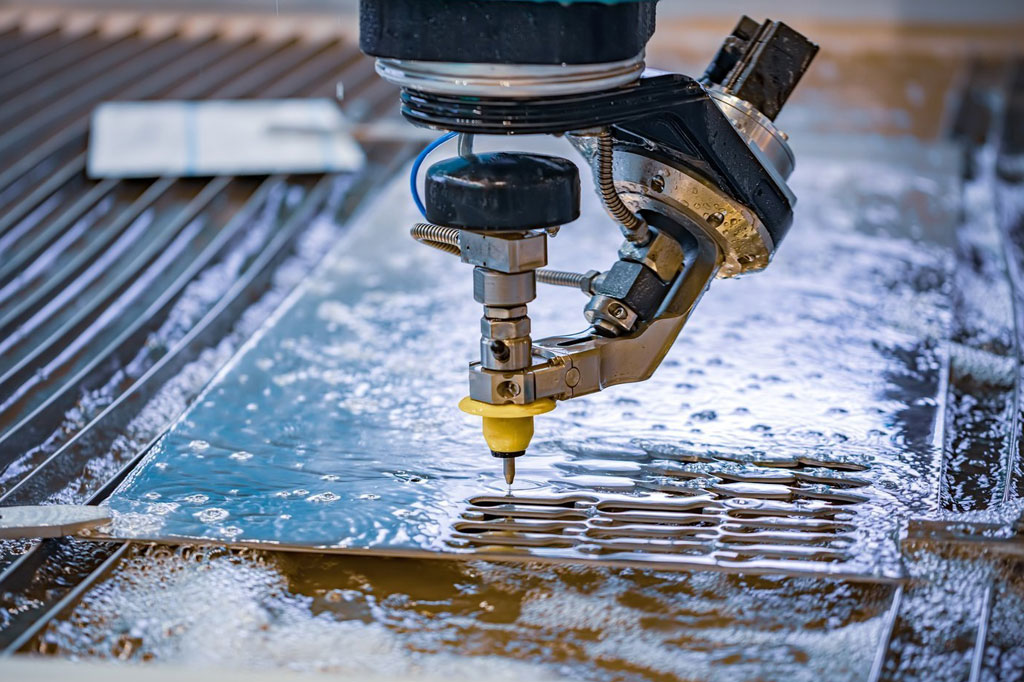Metal cutting is a critical process in manufacturing, shaping, and fabrication. The right method depends on material properties, required precision, and cost-effectiveness.
In this guide, we’ll explore three common metal cutting technologies: laser cutting, plasma cutting, and waterjet cutting.
1. Laser Cutting
Laser cutting employs a high-powered laser beam to melt, burn, or vaporize material with precision. It’s ideal for precise cuts, intricate designs, and a wide range of materials.

How Laser Cutting Works
A laser beam concentrates intense heat onto the material’s surface, causing it to either melt, vaporize, or burn away precisely. The material is often blown away with a stream of gas to help improve precision and cooling.
Laser Cutting Applications
- Materials: Stainless steel, aluminum, mild steel, copper, brass, plastics, wood, and more.
- Thickness: Typically used for materials ranging from thin sheets (0.5mm to 25mm) to thicker plates (up to 100mm or more, depending on the laser power).
- Precision: Delivers exceptionally high precision and smooth edges with minimal heat-affected zones.
- Best For: Ideal for intricate designs, thin to medium-thick materials, and parts requiring tight tolerances.
Laser Cutting Pros & Cons
Pros | Cons |
|
|
2. Plasma Cutting
Plasma cutting utilizes electrically conductive gas (plasma) to cut through metals, making it ideal for thicker materials than laser cutting and highly cost-effective.

How Plasma Cutting Works
Plasma is created by ionizing a gas (such as nitrogen or air) with an electric arc. The plasma stream is focused onto the material, melting it away, while compressed air or gas blows the molten metal off the cut.
Plasma Cutting Applications
- Materials: Steel, aluminum, brass, copper, stainless steel, and other conductive metals.
- Thickness: Suitable for materials between 1mm and 80mm in thickness, with some machines handling up to 150mm.
- Best For: Cutting thicker metals, high-volume cutting, and industrial applications.
Plasma Cutting Pros & Cons
Pros | Cons |
|
|
3. Waterjet Cutting
Waterjet cutting uses a high-pressure water stream, often with added abrasives, to cut through materials. This technique generates no heat, making it suitable for heat-sensitive materials.

How Waterjet Cutting Works
A pump generates extremely high water pressure, forcing water through a tiny nozzle. When combined with an abrasive (such as garnet), the high-velocity water stream erodes the material in a controlled manner.
Waterjet Cutting Applications
- Materials: Metals (steel, stainless steel, aluminum), stone, ceramics, glass, plastics, rubber, and composites.
- Thickness: Suitable for cutting materials up to 200 mm thick, depending on the specific material.
- Best For: Cutting materials sensitive to heat, intricate shapes, or delicate designs.
Waterjet Cutting Pros & Cons
Pros | Cons |
|
|
Summary Comparison Table
Feature | Laser Cutting | Plasma Cutting | Waterjet Cutting |
Materials | Metals, plastics, wood | Conductive metals | Virtually all materials |
Cutting Speed | Fast (thin materials) | Fast (thick materials) | Slower, especially for thick metals |
Thickness Range | 0.5mm - 25mm (up to 100mm) | 1mm - 80mm (up to 150mm) | 1mm - 200mm |
Precision | High precision | Moderate precision | High precision |
Edge Quality | Smooth, clean edges | Rougher edges (secondary finishing) | Smooth, clean edges |
Cost | High initial investment | Lower initial investment | High operating costs |
Choosing the Right Cutting Method
The choice between laser, plasma, or waterjet cutting depends on factors like:
- Material Type: Plasma is ideal for thicker metals, while waterjet is better for heat-sensitive or hard-to-cut materials.
- Thickness of Material: Plasma excels at cutting thick materials quickly, while laser cutting is better for thin sheets. Waterjet is versatile across a broad range of material thicknesses.
- Precision and Finish: Laser cutting offers the highest precision and smoothest finishes. Waterjet also provides clean edges with no heat distortion. Plasma cutting can have rougher edges and may require additional finishing.
- Cost Efficiency: Plasma cutting is generally the most cost-effective for thicker metals, while waterjet and laser cutting offer better precision but at higher costs.

